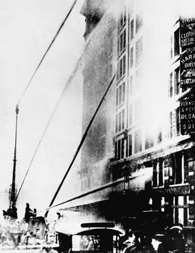On March 25, 1911, a fire at New York City’s crowded, unsafe Triangle Shirtwaist Factory killed 146 workers. Public outrage over the incident galvanized America’s labor movement.
Triangle Workers Trapped in Blaze
The Asch building, a 10-story building in Manhattan’s Greenwich Village, was home to the Triangle Shirtwaist Factory. Its employees, mostly immigrant women, worked long hours sewing shirtwaists—a term for women’s blouses—in the overcrowded and poorly ventilated sweatshop, and received low wages.
In 1909, Triangle workers joined a strike led by the newly formed International Ladies Garment Workers Union and won higher wages and shorter hours. However, their requests for improved workplace and fire safety measures were not met.
On the afternoon of Saturday, March 25, 1911, a pile of garment scraps caught fire on the eighth floor of the Asch building. As several men tried to put out the fire with pails of water and a fire hose, which was not functioning, women successfully escaped through the stairways, fire escape and elevator.
On the 10th floor, workers escaped to the roof where they were able to climb across to the roof of another building; just one of the roughly 70 10th floor workers died. On the ninth floor, however, workers were surrounded by the blaze.
Some workers were able to escape, but the only unlocked stairway was soon blocked by flames and the elevator stopped functioning. The lone fire escape collapsed under the weight of fleeing workers, leaving the remaining workers with no escape.
Some chose to jump rather than burn alive. From the roof, cashier Joseph Fletcher watched “my girls, my pretty ones, going down through the air. They hit the sidewalk spread out and still.”
Firefighters brought the blaze under control within a half hour. Rescue workers searched the scene for survivors as police officers carried off the dead. Of the 250 workers on the ninth floor, 145 died.
“Every available ambulance in Manhattan was called upon to cart the dead to the morgue bodies charred to unrecognizable blackness or reddened to a sickly hue—as was to be seen by shoulders or limbs protruding through flame-eaten clothing,” wrote a reporter for the New York World. “Men and women, boys and girls were of the dead that littered the street; that is actually the condition—the streets were littered.”
Sources in this Story
- University of Missouri-Kansas City’s Law School: 141 Men and Girls Die in Waist Factory Fire
- Global Non-Violent Action Database: Triangle Shirtwaist Factory women strike, win better wages and hours, New York, 1909
- George Mason University: History Matters: Minute by Minute: The World’s Account of the Triangle Fire
- Failure Magazine: Fire Trap—The Legacy of the Triangle Shirtwaist Fire
The Shirtwaist Trial and the Labor Movement
The city was horrified and outraged by the fire, and the International Ladies Garment Workers Union led people into the streets to protest the conditions that resulted in the tragedy. “It will perhaps be discovered that someone was too eager to make money out of human energy to provide the proper safeguards,” declared a reverend at a local church.
Triangle owners Isaac Harris and Max Blanck were indicted for manslaughter for failing to provide adequate fire safety measures and locking a stairway door that could have saved many lives. They were found not guilty, much to the dismay of the public.
The fire galvanized the labor and progressive movements. Membership in unions grew and new worker safety measures were adopted to prevent a similar tragedy. The Democratic Party in New York embraced the ideals of the progressives and became the “leading edge of the working class democratic movement that transformed American politics in the 1930s, ’40s and ’50s,” says historian David von Drehle, author of “Triangle: The Fire That Changed America.”
Resources for Students
The Cornell University Kheel Center for Labor-Management Documentation, in conjunction with the Union of Needletrades, Industrial and Textile Employees, presents a Web site “designed to provide an easily used resource to assist in the writing of class papers” on the Triangle Shirtwaist fire. It includes an overview of the main events with links to primary source material, such as newspaper articles, witness accounts and songs. It also features photographs, audio and a list of victims.











